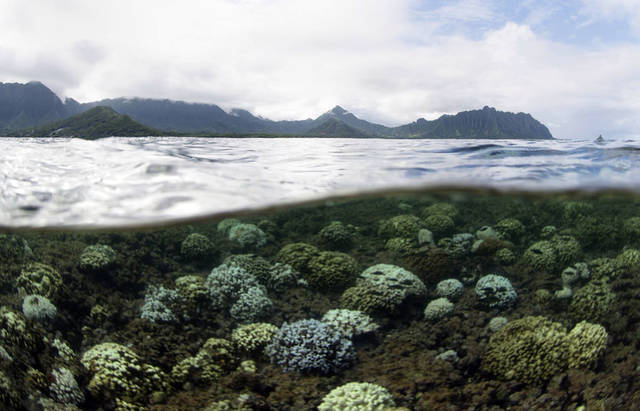UH researchers help map human impacts on Hawaii reefs

XL CATLIN SEAVIEW SURVEY VIA ASSOCIATED PRESS
The coral reef is shown in Kaneohe Bay in Aug. 2015. Abnormally warm water caused by a powerful El Nino pattern is heating up the Pacific Ocean to the point that coral reefs in the waters off Hawaii have already begun to show signs of coral bleaching. The University of Hawaii at Manoa announced today the completion of the first comprehensive map documenting the impact of human activities and natural events on Hawaii’s reef, particularly the slowing recovery from extreme coral bleaching caused by rising water temperatures.
The University of Hawaii at Manoa Opens in a new tab announced today the completion of the first comprehensive map documenting the impact of human activities and natural events on Hawaii’s reef, particularly the slowing recovery from extreme coral bleaching caused by rising water temperatures.
The collaborative Ocean Tipping Points Opens in a new tab study, which appears in PLOS One Opens in a new tab, was a multi-institution collaboration between UH, Stanford University, Stockholm Resilience Center, the National Oceanic and Atmospheric Administration and others.
“When we jumped into the water in West Hawaii, over half of the coral reef was dead,” said the paper’s lead author, Lisa Wedding, a graduate of UH-Manoa’s geography Ph.D. program who is now a research associate at Stanford’s Center for Ocean Solutions, in a news release. “These are some of Hawaii’s most vibrant coral reefs, so we were heartbroken — and determined to better understand how reef ecosystems could be more resilient in the future.”
Researchers from the project synthesized 10 years of data sets from university and government sources to get a big-picture perspective on reef health and regional impacts.
They also reviewed the data to gauge how a broad suite of factors, such as sedimentation, development and fishing, influence coral reef health across the main Hawaiian Islands, and found variations. On densely populated Oahu, for example, fishing and loss of natural habitat to coastal development were the dominant stressors. On less populated isles, sedimentation and nutrient runoff were dominant forces.
The interactive map provides a foundation for further research and informs policies to protect coral reefs, with the team’s findings highlighting the importance of tailoring strategies based on location to effectively address local impacts.
Don't miss out on what's happening!
Stay in touch with breaking news, as it happens, conveniently in your email inbox. It's FREE!
“These layers are being actively used in the ongoing state effort to meet Gov. David Ige’s 30×30 goal Opens in a new tab— protecting 30 percent of the nearshore by 2030 — announced at the World Conservation Conference here in 2016,” said contributing author Kirsten Oleson.
The study, including data, findings and maps, is available for free from the Pacific Islands Ocean Observing System Opens in a new tab(PacIOOS) Opens in a new tab.
Paper co-authors with Hawaii ties include UH Oleson lab Opens in a new tab member Kim Falinski, a marine science advisor to The Nature Conservancy in Honolulu; Hawaii Institute of Marine Biology affiliate Kimberly Selkoe; and former biology faculty member Alan Friedlander. Other UH Ph.D. graduates contributing to the study include Jamison Gove (oceanography), Mary Donovan and Kaylyn McCoy (zoology) and Jack Kittinger (geography).
The research was supported by the Gordon and Betty Moore Foundation, NOAA Coral Reef Conservation Program, United States Department of Agriculture National Institute of Food and Agriculture, and NOAA Hawaiian Islands Humpback Whale National Marine Sanctuary.





